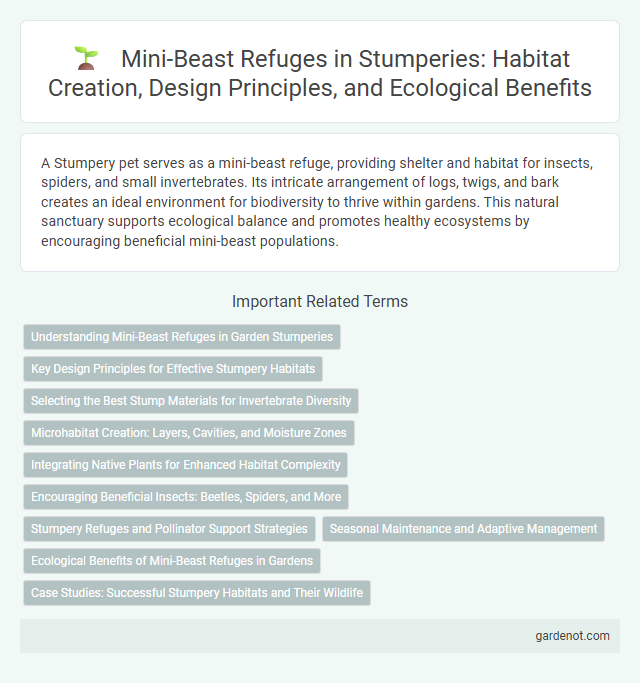A Stumpery pet serves as a mini-beast refuge, providing shelter and habitat for insects, spiders, and small invertebrates. Its intricate arrangement of logs, twigs, and bark creates an ideal environment for biodiversity to thrive within gardens. This natural sanctuary supports ecological balance and promotes healthy ecosystems by encouraging beneficial mini-beast populations.
Understanding Mini-Beast Refuges in Garden Stumperies
Mini-beast refuges in garden stumperies create essential habitats by utilizing decaying wood, bark, and leaf litter to support biodiversity. These refuges attract beneficial insects like beetles, spiders, and woodlice, enhancing ecosystem health and natural pest control. Incorporating diverse plant materials and microhabitats within stumperies maximizes shelter options and food sources for various mini-beasts.
Key Design Principles for Effective Stumpery Habitats
In designing a mini-beast refuge within a stumpery, prioritizing natural materials such as decaying wood, leaf litter, and stones creates an optimal habitat for insects and small invertebrates. Incorporating varied textures and microhabitats helps support biodiversity by offering shelter, breeding sites, and food sources for species like beetles, spiders, and woodlice. Ensuring moisture retention and protection from predators enhances the refuge's effectiveness in sustaining a thriving mini-beast community.
Selecting the Best Stump Materials for Invertebrate Diversity
Choosing the best stump materials for a mini-beast refuge involves selecting decayed hardwoods like oak, ash, and beech, which support higher invertebrate diversity due to their dense structure and moisture retention. Including a variety of stump sizes and stages of decay creates microhabitats that cater to different species such as beetles, millipedes, and woodlice. Ensuring the stumps are placed in shaded, humid areas further enhances their suitability as invertebrate habitats, promoting ecological balance and biodiversity in the garden ecosystem.
Microhabitat Creation: Layers, Cavities, and Moisture Zones
A well-designed stumpery creates essential microhabitats by incorporating diverse layers such as decaying wood, leaf litter, and soil, providing shelter for mini-beasts like beetles and spiders. Cavities and crevices within the rotting stumps offer safe nesting and hibernation sites, while shaded, moist zones support moisture-dependent species including woodlice and earthworms. This layered structure fosters biodiversity by maintaining optimal humidity and temperature gradients crucial for micro-invertebrate survival.
Integrating Native Plants for Enhanced Habitat Complexity
Mini-beast refuges thrive when native plants such as ferns, mosses, and wildflowers are integrated, providing essential shelter and food sources for diverse invertebrates. Using a variety of native species increases habitat complexity, promoting biodiversity and supporting pollinators, decomposers, and predators within the stumpery. Incorporating locally adapted plants ensures resilience in microhabitats, enhancing ecological stability and the overall success of the refuge.
Encouraging Beneficial Insects: Beetles, Spiders, and More
Creating a mini-beast refuge within a stumpery fosters an ideal habitat for beneficial insects like beetles, spiders, and other arthropods that support garden health. These insects contribute to natural pest control by preying on harmful pests, improving soil aeration, and promoting pollination. Integrating log piles, leaf litter, and stones in stumperies enhances biodiversity and encourages a thriving ecosystem of valuable mini-beasts.
Stumpery Refuges and Pollinator Support Strategies
Stumpery refuges provide essential habitats for mini-beasts, enhancing biodiversity by offering shelter and breeding grounds within decaying wood structures. These refuges support pollinator health by integrating native flowering plants that supply nectar and pollen, creating synergistic microhabitats for insects such as bees, beetles, and hoverflies. Strategic placement of stumperies near pollinator-friendly gardens amplifies their role in sustaining ecosystem services including pollination and natural pest control.
Seasonal Maintenance and Adaptive Management
Seasonal maintenance of a mini-beast refuge involves clearing debris to prevent mold and ensuring microhabitats remain moist and sheltered for invertebrates. Adaptive management requires monitoring species diversity and habitat conditions to adjust strategies, promoting biodiversity throughout changing seasons. Regular inspection and habitat enhancement support resilient ecosystems, benefiting pollinators and decomposers alike.
Ecological Benefits of Mini-Beast Refuges in Gardens
Mini-beast refuges in gardens create vital habitats for beneficial insects like beetles, spiders, and ladybugs, enhancing biodiversity and natural pest control. These refuges contribute to soil health by promoting decomposition and nutrient cycling through the activities of detritivores such as woodlice and earthworms. Supporting pollinators like solitary bees also boosts plant reproduction and garden productivity, fostering a balanced and resilient ecosystem.
Case Studies: Successful Stumpery Habitats and Their Wildlife
Mini-beast refuges in successful stumpery habitats provide essential shelter for diverse invertebrates such as beetles, spiders, and woodlice, enhancing local biodiversity. Case studies reveal that strategically placed rotting logs, moss, and leaf litter create microhabitats that support insect breeding and overwintering. These refuges increase population resilience and contribute to balanced garden ecosystems by fostering natural pest control and pollination.
Mini-beast refuge Infographic

 gardenot.com
gardenot.com